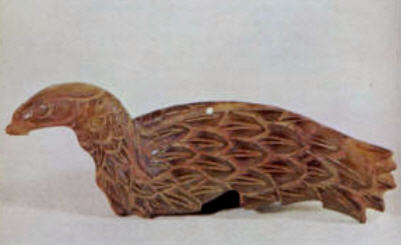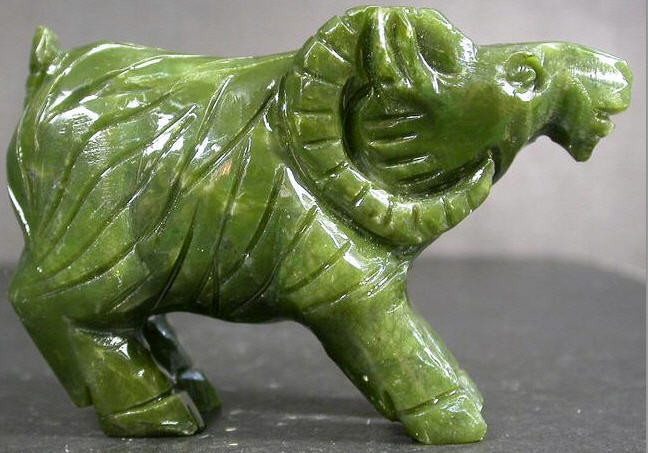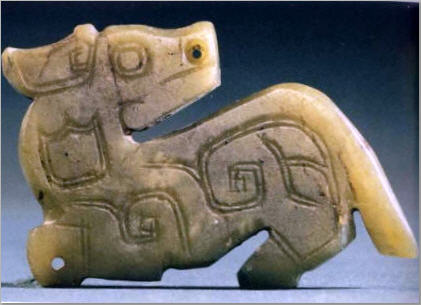Posted By: Bill
Posted Date: Feb 23, 2008 (05:10 PM)
Hi, Jammie:
Thank you very much for your kind comment, you may email me at [email protected]
When I first started collecting jades, many jade "experts" criticized my jades as "modern". (they could very be right at the time.) Yet when I posted the following two questions in this and other forum:
"How modern is modern?"
"What are modern tool marks (found on jade carvings)?"
Nobody seems to be able to answer my questions satisfactorily.
Since then, I have been studying very diligently and learned that it is indeed very difficult to answer the above two questions.
First, "How modern is modern?" regarding a jade carving?
Well it depends in how you define "modern" and I believe "modern" jade carvings can be defined in one of the three following ways:
(1) Modern jade carvings are those jade carvings that are made with modern electrical carving tools assisted with diamond grit(or other grit with high hardness such as corundum). Since such carving tools are operated under high rpm and only goes in one direction (clockwise), therefore the tool marks left on the jade carvings are "modern". Jade carvings in China were made with manual tools until early 1960 when such manual carving tools were replaced with modern electrical tools. Therefore, we may call jade carvings with modern tool marks or those made after 1960 as "modern".
(2) According to laws of China, any antiques that are older than 120 years must have the wax seal for such pieces to be exported out of the country (I can be wrong on this, correct me if I am incorrect). Therefore, we can call any jade carvings that are less than 120 years old "modern".
(3) The Republic of China was established in 1911 and before that it was Qing dynasty - the last dynasty in China. Therefore we may call any jade pieces made after 1910 "modern".
Of course, these are only my recommended definitions for "modern jade carvings". Many jade collectors and experts in this forum may have different ideas and I would love to hear from them.
Now the second question:
"What are modern tool marks?" is a six million dollar question and not even jade experts can agree on the answers.
First of all, some carving marks left by modern electrical tools are very similar to those left by manual carving tools.
To make matters complicate, it is possible some modern jade copies are still made with manual jade carving tools.
Even with manual carving tools, there are six different types of manual tu (a metal or stone wheel used in cutting, polishing and carving jades) since the early ages in China.
It is not easy to differentiate between even tool marks left by metal carving tools or stone carving tools.
There is no universal agreement in what types of carving tools were available in the new stone ages in China because not too many of such tools survived today and therefore tool marks left by such tools were very difficult to understand. Even in the Shang dynasty, we knew they had metal carving tools made of bronze, however since bronze was such precious metal at the time, many of such metal carving tools were melted down after a jade piece was finished for other uses. Therefore, not too many bronze carving tools are available for study today.
Many jade experts simply do not know or cannot agree in how tool marks found on jade pieces carvings in different dynasties or from different cultures in ancient China should look like.
What irks me the most is many jade "experts" in this or other forum simply did not have any concrete reasoning when they call a jade piece "modern".
The pieces may just appear to be modern to them based on their own personal experience in collecting jades and/or their personal feeling toward the jade piece. Very often, if a jade piece is made so bad that it looks like it was made yesterday, their opinions of course would be right on the money and there would be almost an universal agreement among the forum members (like the modern fish jade carving posted here in the forum) However, very often, a jade piece that is unusual in its style, form, material and carving, it would be very difficult if not impossible in dating such a piece without being able to personally handle and examine it. Yet some of them would just call it "modern" without any explanation or evidence presented in supporting their opinions.
A celadon jade slit ring I posted in another thread had experienced such fate. The dZi beads and buddha head jade carving posted by Randy in the main forum had experienced similar fates. (One or two experts did bring up some good arguments regarding the jade buddha head piece). It makes me wonder how much many of these experts really know what they are talking about?
The celadon jade slit ring I posted in this forum was a genuine archaic jade slit ring due to its unique high quality nephrite material (now extinct), its genuine weathering but most important of all it was based on my study of tool marks. It simply was made modernly because the cut at its slit was simply too uneven to be made with a metal blade or even a stone tu with grit. It was indeed made with two string cuts. Such string cuts were only seen during stone ages. Nobody would be stupid enough in trying to make a modern jade piece with string cut because the labor involved would be simply too time consuming and therefore unprofitable. Then they had to put such genuine weathering on it after they made it. If you do not believe me, please find a piece of similar quality celadon nephrite jade like my slit ring (it would be a difficult task by itself),get a piece of string (animal tendon, bamboo or tree bark string, etc.) then try to cut a slit on it with quartz grit (with two cuts) and see how long it will take you to complete such task.
Yet this one dealer in China had the audacity to call it "modern" without any explanations despite the fact that two of my experienced jade friends had called it "archaic". When I challenged him to post pictures of similar jade slit rings or sell me as many similar pieces he could find for me at "modern fake" prices he never give me any concrete responses. It is almost like when you play poker, and when the other party call you bluff you simply fold your cards.
I never claim I am a jade expert and very often I admit I was wrong. However, I have been spending as much money in acquiring jade books as the amount spent in acquiring jade pieces and had spent a lot of time in studying anything to do with jades. When I began to understand more about tool marks, I was disgusted in finding out that indeed many of my archaic Hongshan jade pieces could not possibly be authentic neolithic jade pieces because metal tool marks were found on them. However, when I posted a genuine HS piece with all the characteristics of authentic Hongshan jade pieces, it was being attacked and ridiculed from top to bottom by people who really did not understand Hongshan. It makes me understand it is indeed very difficult in both authenticating and dating a jade piece. There are simply so much to learn, even for established jade experts. Therefore we should not call any jade pieces posted in this forum "modern" unless we are 99% sure and can present convincing evidence.
I am going to post pictures of three pieces of jade carvings here and let all members decide if they are modern or not. If they can explain in how they make their decision or in estimating how old (or what dynasty) or modern each piece is, I would appreciate very much. This test is not my attempt to put down anybody but in showing how difficult it is in deciding what a "modern" jade carving is.
Bill


